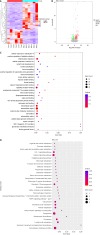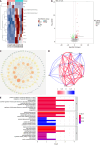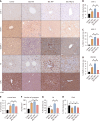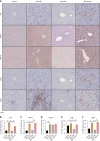Platelet activation relieves liver portal hypertension via the lymphatic system though the classical vascular endothelial growth factor receptor 3 signaling pathway
- PMID: 40093669
- PMCID: PMC11886527
- DOI: 10.3748/wjg.v31.i10.100194
Platelet activation relieves liver portal hypertension via the lymphatic system though the classical vascular endothelial growth factor receptor 3 signaling pathway
Abstract
Background: Liver cirrhosis and portal hypertension (PHT) can lead to lymphatic abnormalities and coagulation dysfunction. Because lymphangiogenesis may relieve liver cirrhosis and PHT, the present study investigated the gene expression alterations in the lymphatic system and the effectiveness of platelet-mediated lymphangiogenesis in improving liver cirrhosis and PHT.
Aim: To investigate the role of lymphangiogenesis in preclinical PHT models.
Methods: Immunohistochemistry and transcriptome sequencing of bile duct ligation (BDL) and control lymphatic samples were conducted to reveal the indicated signaling pathways. Functional enrichment analyses were performed on the differentially expressed genes and hub genes. Adenoviral infection of vascular endothelial growth factor C (VEGF-C), platelet-rich plasma (PRP), and VEGF3 receptor (VEGFR) inhibitor MAZ-51 was used as an intervention for the lymphatic system in PHT models. Histology, hemodynamic tests and western blot analyses were performed to demonstrate the effects of lymphatic intervention in PHT patients.
Results: Lymphangiogenesis was increased in the BDL rat model. Transcriptome sequencing analysis of the extrahepatic lymphatic system revealed its close association with platelet adherence, aggregation, and activation. The role of PHT in the rat model was investigated by activating (PRP) and inhibiting (MAZ-51) the lymphatic system. PRP promoted lymphangiogenesis, which increased lymphatic drainage, alleviated portal pressure, reduced liver fibrosis, inhibited inflammation, inhibited angiogenesis, and suppressed mesenteric artery remodeling. MAZ-51 reversed the above improvements.
Conclusion: Via VEGF-C/VEGFR-3, platelets impede fibrosis, angiogenesis, and mesenteric artery remodeling, ultimately alleviating PHT. Thus, platelet intervention is a therapeutic approach for cirrhosis and PHT.
Keywords: Cirrhosis; Lymphangiogenesis; Platelets; Portal hypertension; Vascular endothelial growth factor C.
©The Author(s) 2025. Published by Baishideng Publishing Group Inc. All rights reserved.
Conflict of interest statement
Conflict-of-interest statement: The authors have no conflicts of interest to declare.
Figures








Similar articles
-
Activation of lymphangiogenesis by platelet as novel therapeutic approaches for liver cirrhosis and portal hypertension.World J Gastroenterol. 2025 Jun 21;31(23):107554. doi: 10.3748/wjg.v31.i23.107554. World J Gastroenterol. 2025. PMID: 40575337 Free PMC article.
-
S-Allyl-Cysteine Ameliorates Cirrhotic Portal Hypertension by Enhancing Lymphangiogenesis via a VEGF-C-Independent Manner.Liver Int. 2025 Mar;45(3):e70024. doi: 10.1111/liv.70024. Liver Int. 2025. PMID: 39967382
-
Activation of AMP-activated Protein Kinase by Metformin Inhibits Dedifferentiation of Platelet-derived Growth Factor-BB-induced Vascular Smooth Muscle Cells to Improve Arterial Remodeling in Cirrhotic Portal Hypertension.Cell Mol Gastroenterol Hepatol. 2025;19(6):101487. doi: 10.1016/j.jcmgh.2025.101487. Epub 2025 Feb 28. Cell Mol Gastroenterol Hepatol. 2025. PMID: 40024535 Free PMC article.
-
Roles of the TGF-β⁻VEGF-C Pathway in Fibrosis-Related Lymphangiogenesis.Int J Mol Sci. 2018 Aug 23;19(9):2487. doi: 10.3390/ijms19092487. Int J Mol Sci. 2018. PMID: 30142879 Free PMC article. Review.
-
Molecular control of lymphatic metastasis.Ann N Y Acad Sci. 2008;1131:225-34. doi: 10.1196/annals.1413.020. Ann N Y Acad Sci. 2008. PMID: 18519975 Review.
Cited by
-
Activation of lymphangiogenesis by platelet as novel therapeutic approaches for liver cirrhosis and portal hypertension.World J Gastroenterol. 2025 Jun 21;31(23):107554. doi: 10.3748/wjg.v31.i23.107554. World J Gastroenterol. 2025. PMID: 40575337 Free PMC article.
References
-
- Gracia-Sancho J, Marrone G, Fernández-Iglesias A. Hepatic microcirculation and mechanisms of portal hypertension. Nat Rev Gastroenterol Hepatol. 2019;16:221–234. - PubMed
-
- Tsochatzis EA, Bosch J, Burroughs AK. Liver cirrhosis. Lancet. 2014;383:1749–1761. - PubMed
-
- Maby-El Hajjami H, Petrova TV. Developmental and pathological lymphangiogenesis: from models to human disease. Histochem Cell Biol. 2008;130:1063–1078. - PubMed
MeSH terms
Substances
LinkOut - more resources
Full Text Sources
Medical
Research Materials

